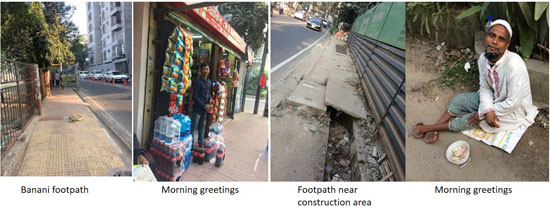Authors: Nova Ahmed
Posted: Tue, February 05, 2019 - 10:27:01
Some colleagues and I once had a big debate about whether technology separates us or connects us. At one point, someone argued that people do not even greet each other these days in Dhaka city.
I was not ready to give it up—I wanted to look into it myself. I had two motivations: the first one was to find out whether people are willing to greet you regardless of what they are busy with; the second one was a personal goal to make myself go for walks (with a bigger goal to lose weight!).
Route
Over a period of six months, twice a week I walked a long path of five kilometers from my home in Banani to my workplace in Bashundhara, in Dhaka. I greeted everyone I met on my way to find out whether I would be greeted back. I also wanted to see how many people were busy with their phones in the morning. My final goal was to let other curious researchers know if a fun project can motivate you to go out, walk, and lose weight. Here’s what I found out: People love greetings, even when they are busy with other tasks and even when they are busy talking on their phones. The bad news is there is no way to lose weight during interesting projects … based on my walking results.

Banani, a high-income region.
The journey
My journey would start early in the morning between 7 and 9 AM, beginning in summer and ending in winter (June to December 2018). It covered walkways, intersections, residential areas, and bazaar (streetside shops) areas of Dhaka. I took the same route, two days a week. I would greet almost anyone I came across with a smile, even when not making eye contact. I was known to many of them by the end of my walking journey. That’s when I took a few photos with their permission, letting them know that I would use them with this post. All of the people I approached posed; some requested me to post them on social media along with this blog post!

Nodda, a low-income region.
Observations
Here is how my journey worked out: I would start in Banani, a residential area. Early in the morning, there were guards in front of the buildings I passed. On the road there were some shopkeepers getting ready to open up doing their morning rituals, and groups of women walking on foot toward the garment workshops in that area, most of the time walking in groups. They all seemed extremely happy, returning my greetings with a smile. I did not see anyone in this area using technology while passing them in the morning.
I passed the beggars in Banani-Gulshan intersection. The beggars normally put on a depressing face. However, they responded to my greeting with a smile, and then immediately returned to their sad facial expressions. This group does not use technology while going about their business.
There are about 30 people on the route from Gulshan to Bashundhara—some busy setting up their business by the roads and some walking toward their work. Many of the people (around 4 to 5) would be busy talking on the phone as they walked by. Some were extremely busy setting up shops or getting themselves ready. Multitasking is common, as I once saw a person brushing his teeth, talking on the phone, and trying to open his shop at the same time. I saw people busy with technology and without technology. In both cases, my morning greetings were returned. Some of the people talking on the phone just nodded to me. The best response I received was from a person on their phone who came running after me, putting his phone on hold, just to return me my greeting.

Toward Bashundhara, a mid-income region.
There were two specific incidents of harassment where I heard bad comments as I walked by. One was from a rickshaw puller making a comment about how women should not walk that fast, followed by a degrading word. The second was from an unknown passerby, who made an abusive comment.
One day I fell down on the road and was hit unintentionally by a cycle rider. There was a blind spot where we could not see each other. It took place in November. All the people around the road came running toward me. One kind rickshaw puller told me to take rest, addressing me as amma (mother). These greetings were not just random interactions—they had something more to them than that.
Results
My roadside experiment came to an end around December when it was revealed that the roads may not be safe during the election period.
My first quest to find out whether people have forgotten to greet each other with the presence of technology revealed that interaction in any form brings about new interactions. Only lack of interaction creates a distance. Human interactions are still prioritized over technology, or were at least not ignored in the presence of other distractions.
The second goal of losing weight while conducting an interesting experiment did not meet my expectations. As the project seemed interesting, I was busy observing people, stopping to greet them, and smiling, which did not result in losing any weight.
Conclusion
It has been my pleasure to walk you through the streets of Dhaka. Anyone who has visited the city would agree that we love human interaction, even when we are occasionally busy with mobile phones or other technology artifacts.
Thank you!
Posted in: on Tue, February 05, 2019 - 10:27:01
Nova Ahmed
View All Nova Ahmed's Posts






Post Comment
No Comments Found